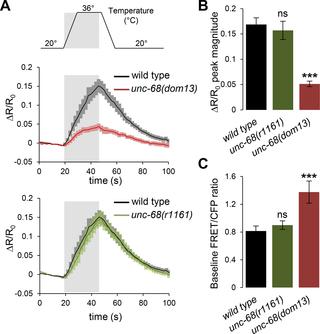当前位置:
X-MOL 学术
›
PLOS Genet.
›
论文详情
Our official English website, www.x-mol.net, welcomes your feedback! (Note: you will need to create a separate account there.)
Identification of avoidance genes through neural pathway-specific forward optogenetics.
PLOS Genetics ( IF 4.5 ) Pub Date : 2019-12-31 , DOI: 10.1371/journal.pgen.1008509 Filipe Marques 1 , Gabriella Saro 1 , Andrei-Stefan Lia 1 , Richard J Poole 2 , Laurent Falquet 1, 3 , Dominique A Glauser 1
PLOS Genetics ( IF 4.5 ) Pub Date : 2019-12-31 , DOI: 10.1371/journal.pgen.1008509 Filipe Marques 1 , Gabriella Saro 1 , Andrei-Stefan Lia 1 , Richard J Poole 2 , Laurent Falquet 1, 3 , Dominique A Glauser 1
Affiliation

|
Understanding how the nervous system bridges sensation and behavior requires the elucidation of complex neural and molecular networks. Forward genetic approaches, such as screens conducted in C. elegans, have successfully identified genes required to process natural sensory stimuli. However, functional redundancy within the underlying neural circuits, which are often organized with multiple parallel neural pathways, limits our ability to identify 'neural pathway-specific genes', i.e. genes that are essential for the function of some, but not all of these redundant neural pathways. To overcome this limitation, we developed a 'forward optogenetics' screening strategy in which natural stimuli are initially replaced by the selective optogenetic activation of a specific neural pathway. We used this strategy to address the function of the polymodal FLP nociceptors mediating avoidance of noxious thermal and mechanical stimuli. According to our expectations, we identified both mutations in 'general' avoidance genes that broadly impact avoidance responses to a variety of natural noxious stimuli (unc-4, unc-83, and eat-4) and mutations that produce a narrower impact, more restricted to the FLP pathway (syd-2, unc-14 and unc-68). Through a detailed follow-up analysis, we further showed that the Ryanodine receptor UNC-68 acts cell-autonomously in FLP to adjust heat-evoked calcium signals and aversive behaviors. As a whole, our work (i) reveals the importance of properly regulated ER calcium release for FLP function, (ii) provides new entry points for new nociception research and (iii) demonstrates the utility of our forward optogenetic strategy, which can easily be transposed to analyze other neural pathways.
中文翻译:

通过特定于神经途径的正向光遗传学鉴定回避基因。
要了解神经系统如何桥接感觉和行为,就需要阐明复杂的神经和分子网络。向前的遗传方法,例如在秀丽隐杆线虫中进行的筛选,已成功鉴定出处理自然感觉刺激所需的基因。但是,底层神经回路中的功能冗余通常由多个平行的神经通路组成,这限制了我们识别“神经通路特定基因”的能力,即某些某些(但不是全部)冗余功能所必需的基因神经通路。为了克服这一局限性,我们开发了一种“正向光遗传学”筛选策略,其中自然刺激最初被特定神经通路的选择性光遗传学激活所取代。我们使用这种策略来解决多峰FLP伤害感受器的功能,该介导可避免有害的热刺激和机械刺激。根据我们的期望,我们确定了“一般性”回避基因中的突变(广泛影响对各种自然有害刺激(unc-4,unc-83和eat-4)的回避反应)和产生更窄影响的突变。限于FLP途径(syd-2,unc-14和unc-68)。通过详细的跟踪分析,我们进一步表明,Ryanodine受体UNC-68在FLP中具有细胞自主作用,可以调节热诱发的钙信号和厌恶行为。总体而言,我们的工作(i)揭示了适当调节的ER钙释放对于FLP功能的重要性,
更新日期:2019-12-31
中文翻译:

通过特定于神经途径的正向光遗传学鉴定回避基因。
要了解神经系统如何桥接感觉和行为,就需要阐明复杂的神经和分子网络。向前的遗传方法,例如在秀丽隐杆线虫中进行的筛选,已成功鉴定出处理自然感觉刺激所需的基因。但是,底层神经回路中的功能冗余通常由多个平行的神经通路组成,这限制了我们识别“神经通路特定基因”的能力,即某些某些(但不是全部)冗余功能所必需的基因神经通路。为了克服这一局限性,我们开发了一种“正向光遗传学”筛选策略,其中自然刺激最初被特定神经通路的选择性光遗传学激活所取代。我们使用这种策略来解决多峰FLP伤害感受器的功能,该介导可避免有害的热刺激和机械刺激。根据我们的期望,我们确定了“一般性”回避基因中的突变(广泛影响对各种自然有害刺激(unc-4,unc-83和eat-4)的回避反应)和产生更窄影响的突变。限于FLP途径(syd-2,unc-14和unc-68)。通过详细的跟踪分析,我们进一步表明,Ryanodine受体UNC-68在FLP中具有细胞自主作用,可以调节热诱发的钙信号和厌恶行为。总体而言,我们的工作(i)揭示了适当调节的ER钙释放对于FLP功能的重要性,



























 京公网安备 11010802027423号
京公网安备 11010802027423号